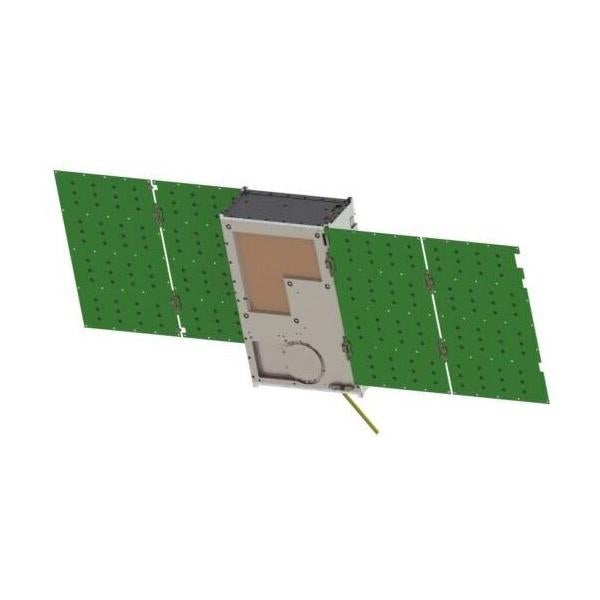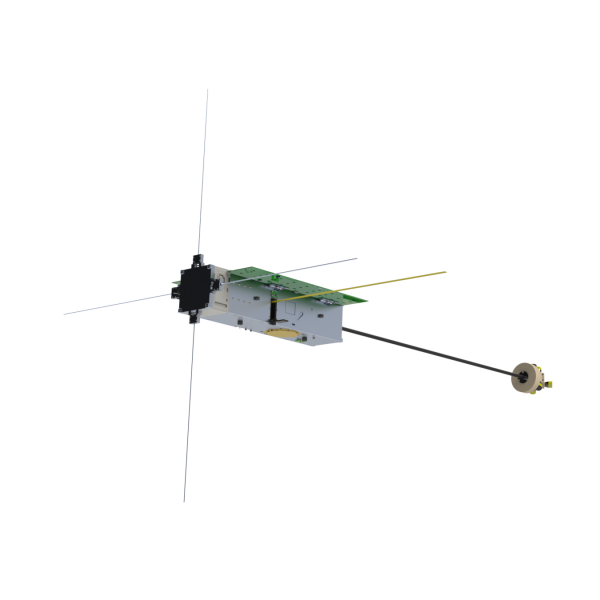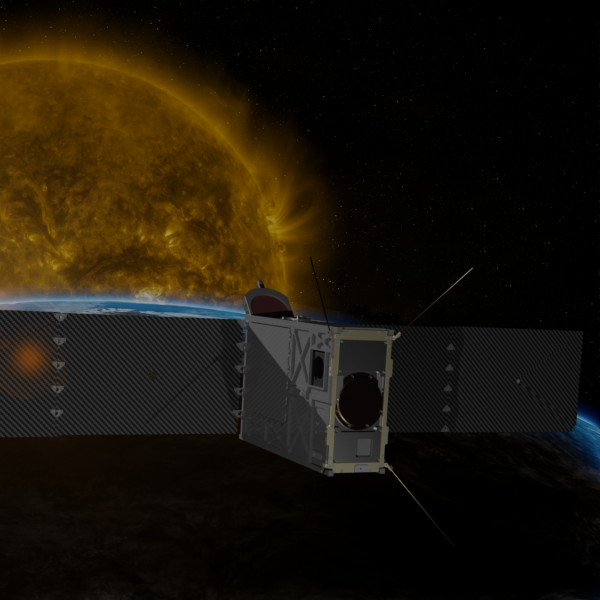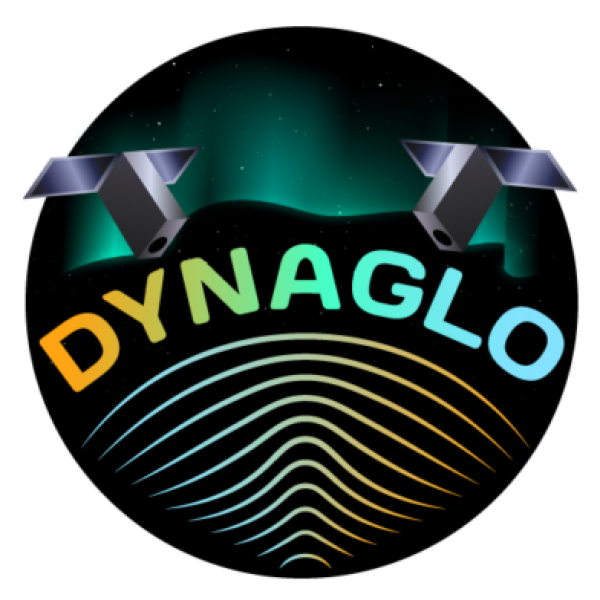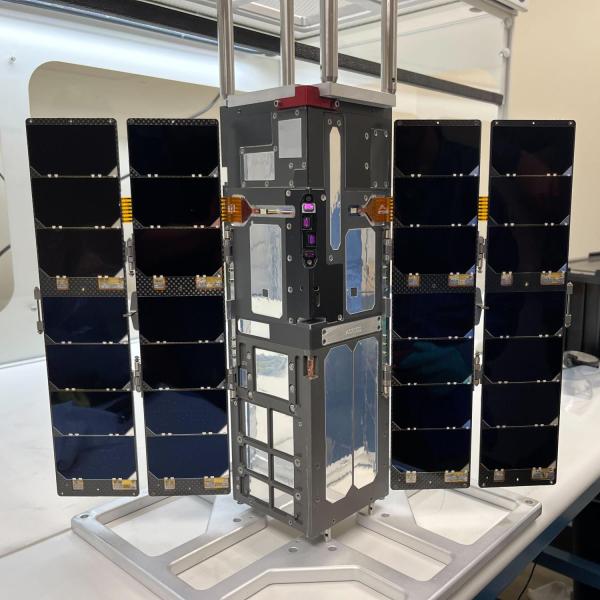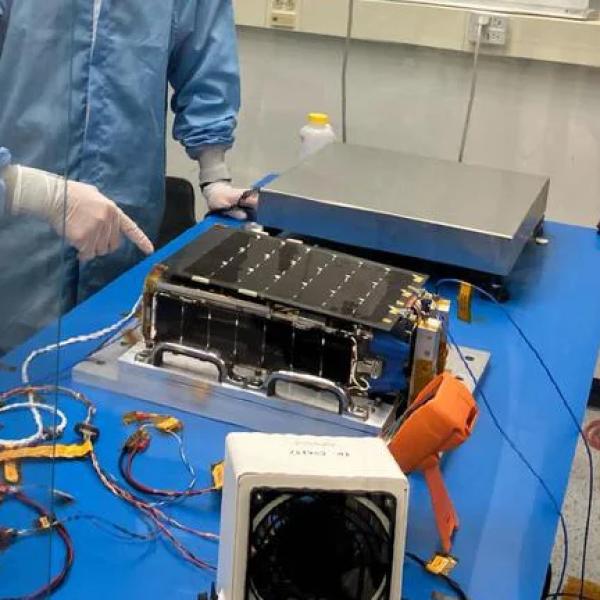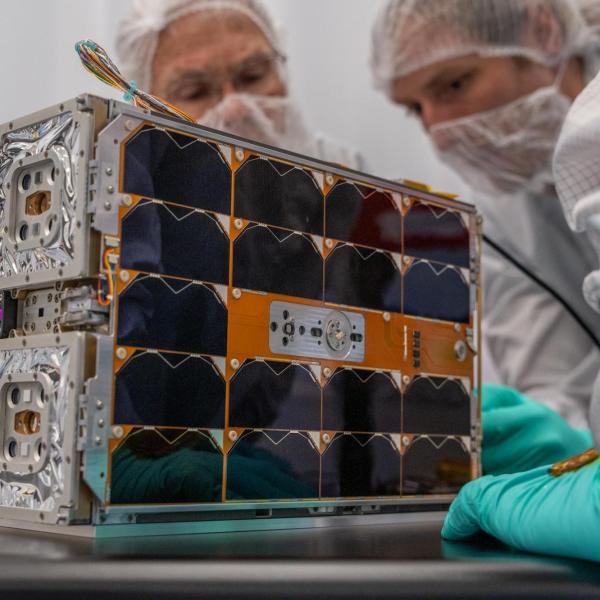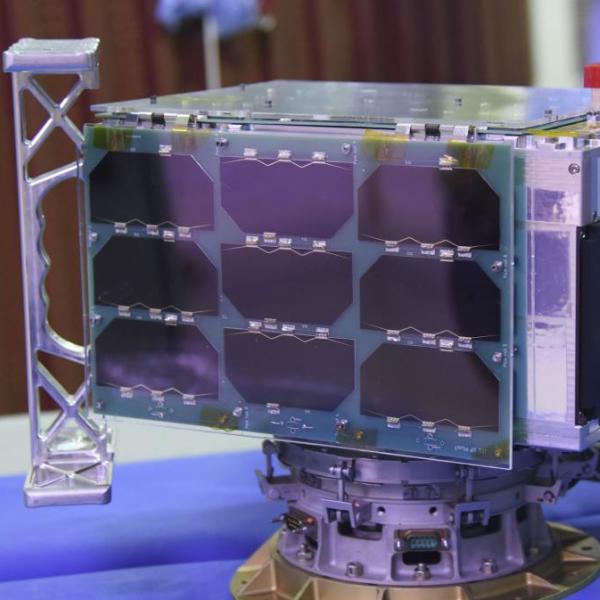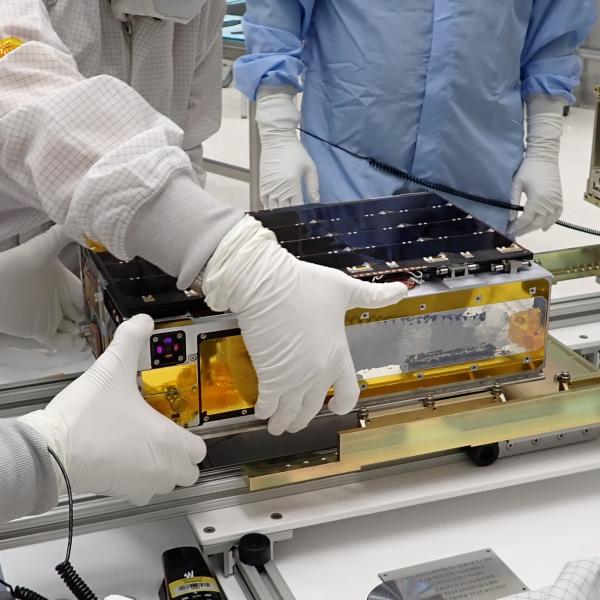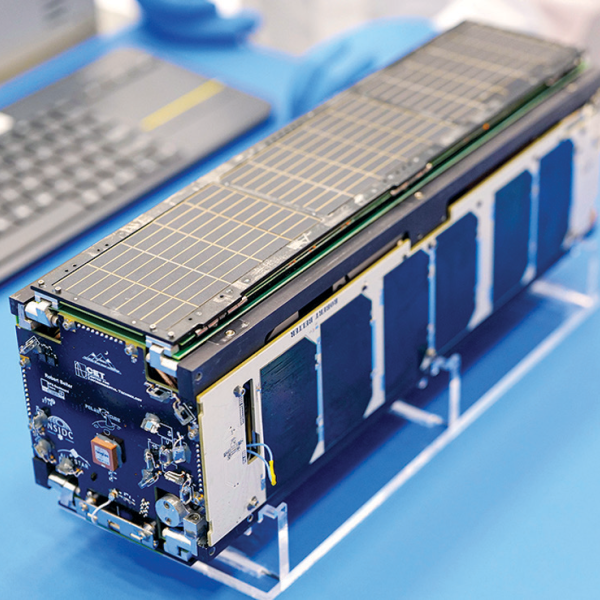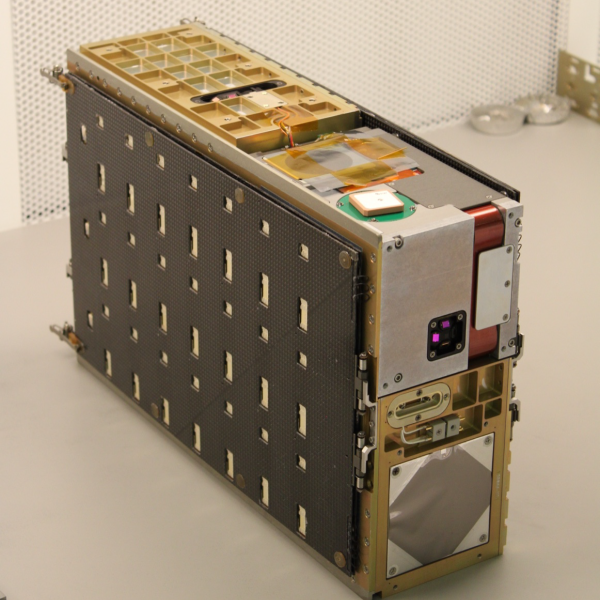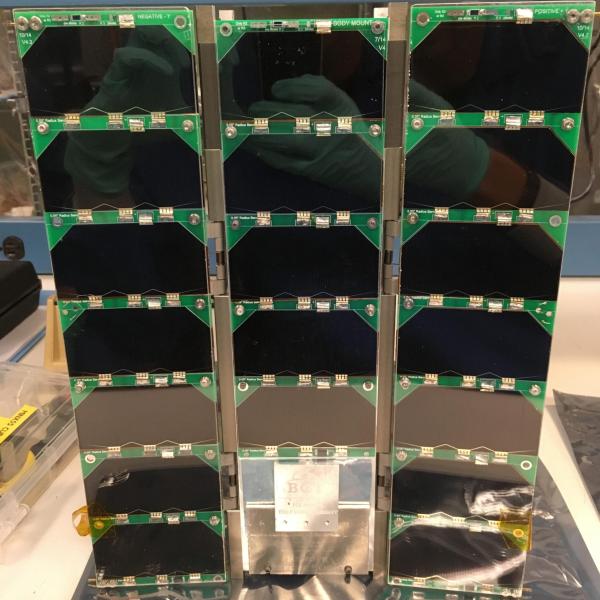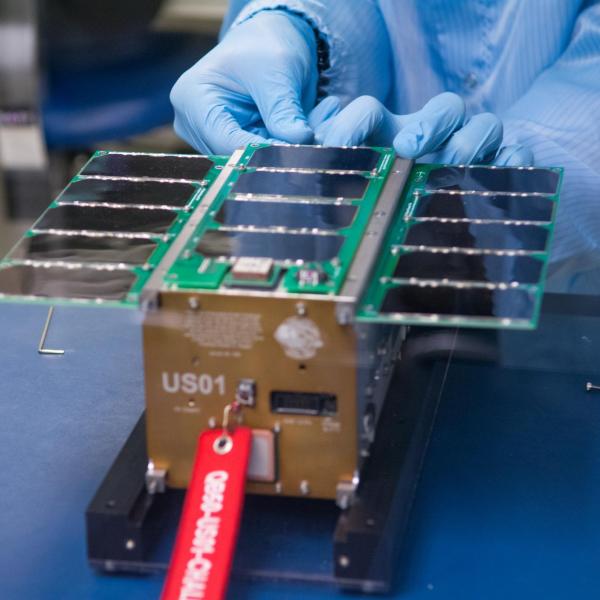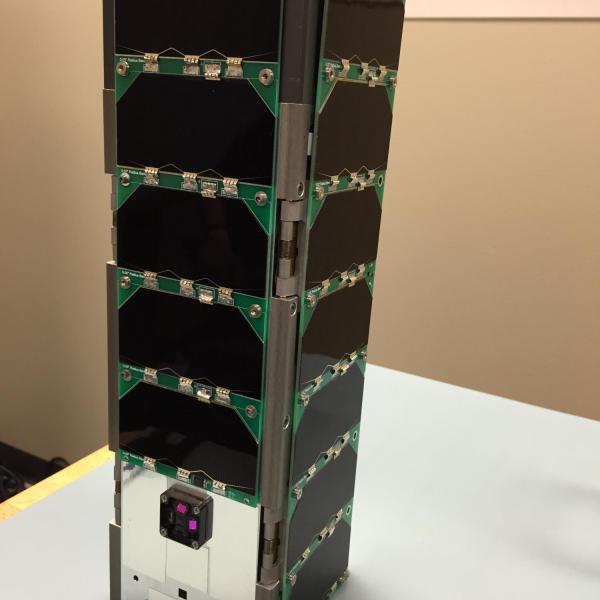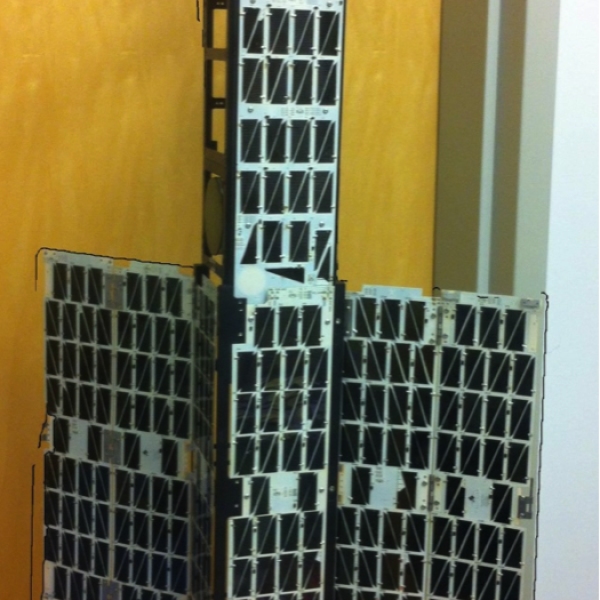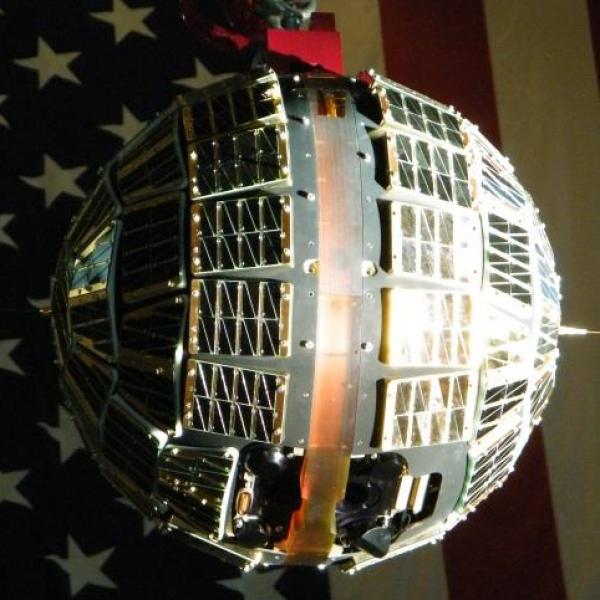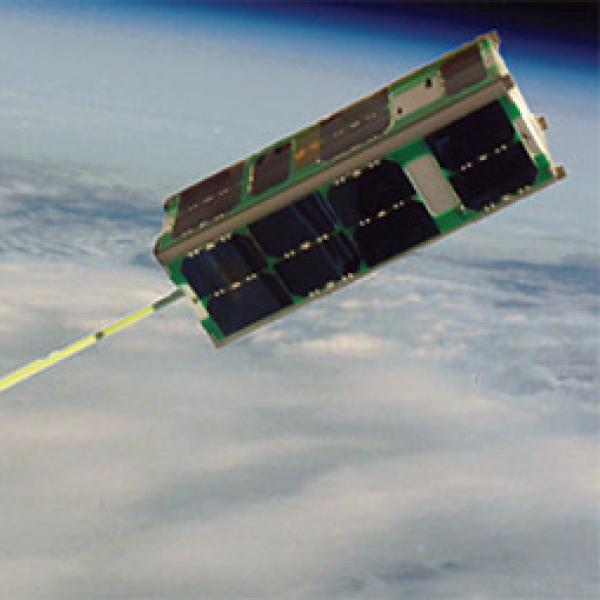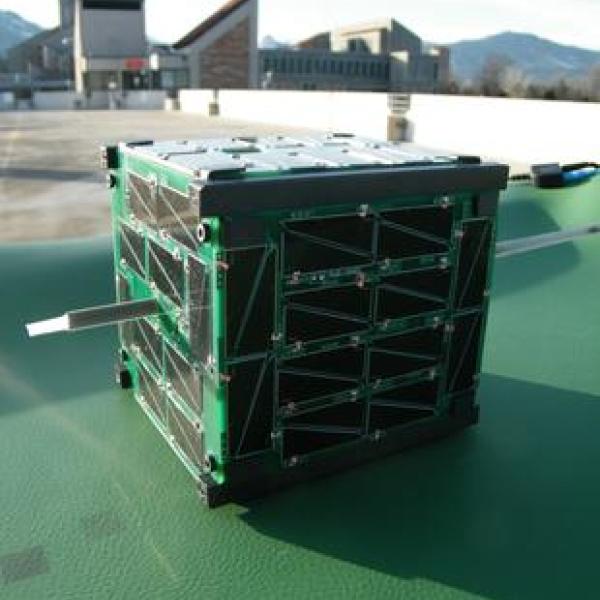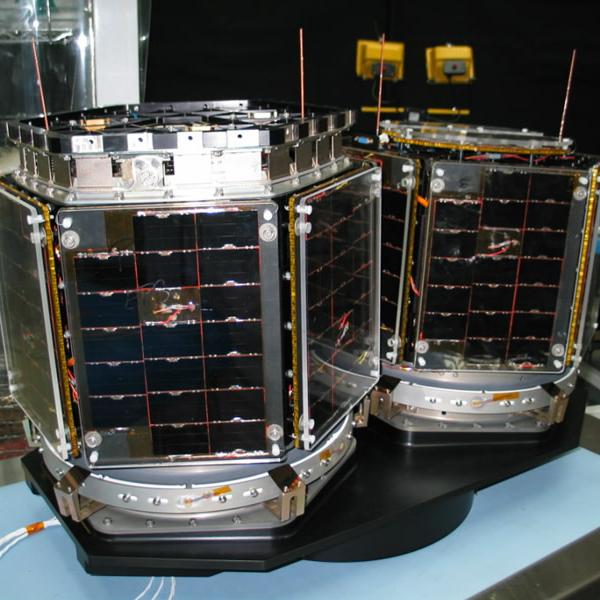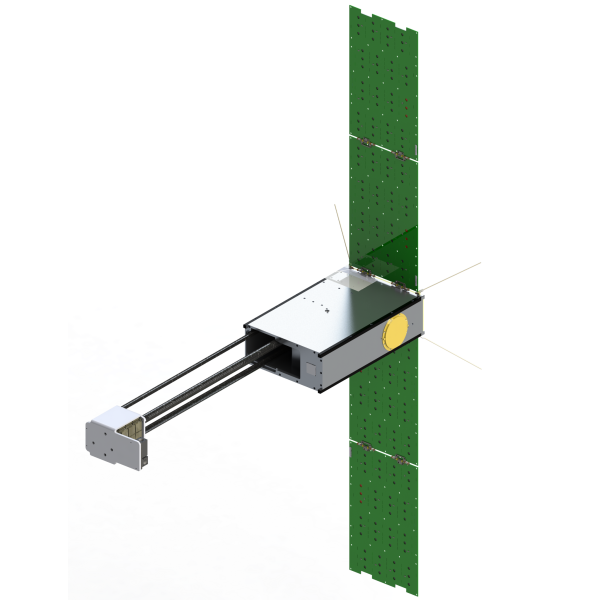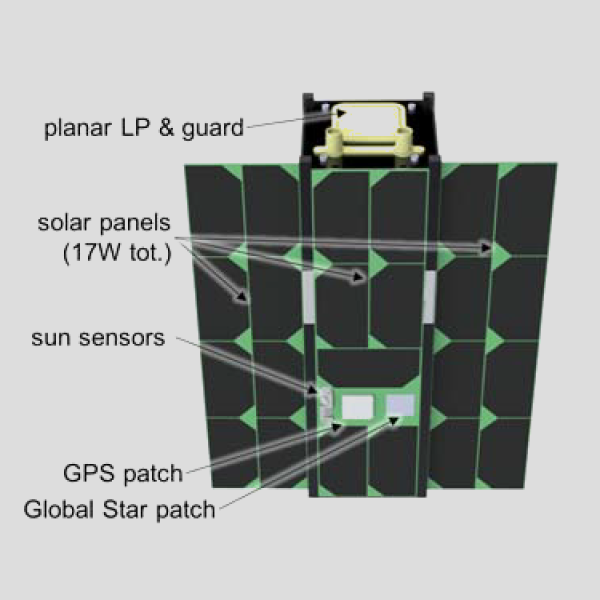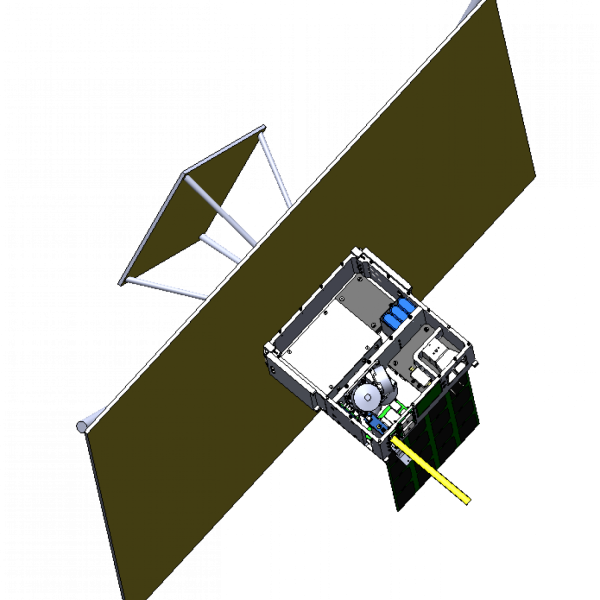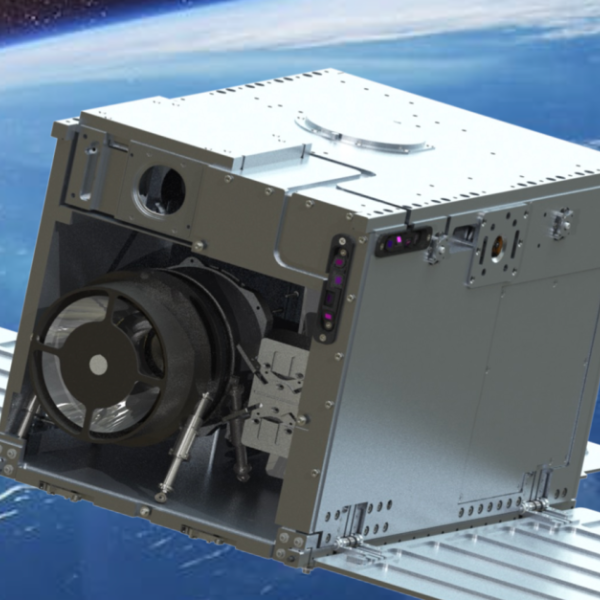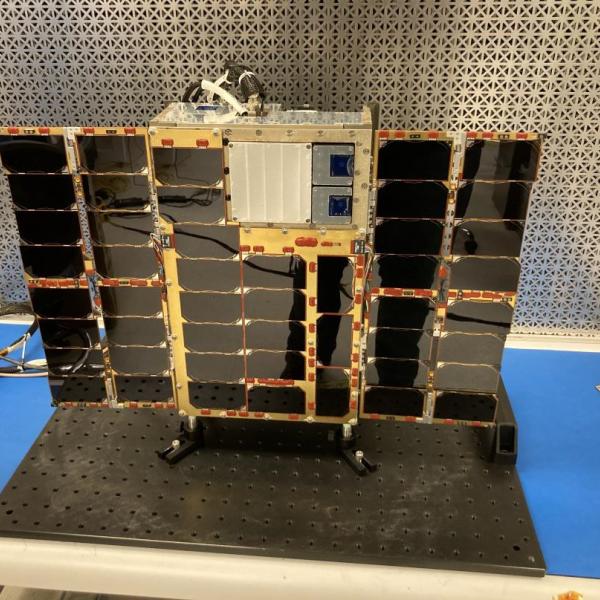CU Boulder CubeSats
CU Boulder students, faculty, and researchers are building and launching nano satellites for scientific research and to test new space technology.
We've worked on over two dozen unique CubeSats, with current, former, and planned projects discussed below, including mission details and links to more information, where available.
Listed below:
- Launching Soon - In 2025
- Currently In Orbit or Post-Mission
- Looking Further Out (2026+)
Atmospheric Effects of Precipitation through Energetic X-rays
Mission: Investigate electrons that fall into Earth’s atmosphere from the Van Allen radiation belts. These electrons interact with the atmosphere and have major implications for the atmospheric ozone balance.
Launch Date: Mar. 2026
Rocket Name: SpaceX Transporter 16
Associated Teams: Smead Aerospace, LASP
Principal Investigator: Robert Marshall
Co-Investigators:Dan Baker, Cora Randall, Tom Woods
Primary Funding: NASA
Climatology of Anthropogenic and Natural VLF wave Activity in Space.
Mission: Map the transmission of VLF energy from the ground into space, injected by both lightning and VLF transmitters.
Launch Date: April 2026
Rocket Name: USSF STP-S29A
Associated Teams: Smead Aerospace
Principal Investigator: Robert Marshall
Co-Investigators: Scott Palo, David Malaspina
Primary Funding: NSF
Notes: Awarded $1.2m over four years by NSF on 12/10/2018
SunCoronal Ejection Tracker
Mission: Studying coronal mass ejections to better protect critical infrastructure.
Launch Date: Oct. 2025
Associated Teams: LASP
Principal Investigator: James Mason
Primary Funding: NASA
DYNamics Atmosphere GLObal-Connection
Mission: Two CubeSat constellation to globally map and characterize atmospheric gravity waves present in Earth’s thermosphere to fill a crucial observation gap in the ionosphere-thermosphere region.
Launch Date: Late 2025
Associated Teams: LASP
Principal Investigator: Aimee Merkel
Primary Funding: NASA
Supernova Remnants and Proxies for Re-Ionization Testbed Experiment
Mission: Determine how gas and dust are processed in galaxies by star-formation and supernovae, and how energetic ionizing radiation is transported from hot stars into the intergalactic medium.
Launch Date (planned): Late 2025
Associated Teams: LASP, APS
Principle Investigator: Brian Fleming
Primary Funding: NASA
Notes: NASA’s first 12U CubeSat
Cubesat: Inner Radiation Belt Experiment
Mission: Provide sophisticated, fine-grain measurements of the Van Allen Belts.
Launch Date: April 15, 2023
Rocket Name: Transporter 7 on SpaceX F9 Rocket
Launch Location: Vandenberg Space Force Base
Service Dates: April 15, 2023 - Oct. 4, 2024. Mission success.
Deorbited: Oct. 4, 2024
Associated Teams: Smead Aerospace, LASP
Principal Investigator: Xinlin Li
Co-Investigator: Scott Palo
Primary Funding: NASA
Mission: Determine the presence or absence of exposed water ice on the Moon and map its concentration at the 1-2 kilometer scale
Launch Date: Dec. 11, 2022
Rocket Name: Hakuto-R Mission 1
Launch Location: Cape Canaveral
Service Dates: Dec. 11, 2022 - May 12, 2023
Deorbited: Still flying
Associated Teams: JPL, NASA Marshall
Principal Investigator: Dr. Barbara Cohen (NASA Marshall)
Co-Investigator:Paul Hayne (Dept. of Astrophysics, LASP)
Compact Total Irradiance Monitor Flight Demonstration
Mission: Demonstrate next-generation technologies for monitoring of Total Solar Irradiance
Launch Date: July 2, 2022
Rocket Name: Space Test Program-S28 (STP-S28A) - LauncherOne
Launch Location: Mojave Air and Space Port
Service Dates: July 2, 2022 - Dec. 3, 2023. Mission success
Deorbited: Dec. 3, 2023
Associated Teams: LASP, NIST
Principal Investigator: Dave Harber
Co-Investigators: Greg Kopp, Peter Pilewskie
Primary Funding: NASA Earth Science Technology Office
INternational Satellite Program In Research and Education Satellite
Mission: Ionospheric measurements, which will advance our understanding of ionosphere dynamics and plasma transport.
Launch Date: Feb. 14, 2022
Launch Location: Satish Dhawan Space Centre, India
Rocket Name: Polar Satellite Launch Vehicle C-52
Service Dates: Feb. 14, 2022 - Present
Deorbited: Still flying
Associated Teams: LASP
Principal Investigator: Amal Chandran
Notes: Multi-nation multi-university CubeSat project
Colorado Ultraviolet Transit Experiment
Mission: Characterize the composition and mass-loss rates of exoplanet atmospheres.
Launch Date: Sept. 27, 2021
Rocket Name: LandSat-9 / ELaNa 34
Launch Location: Vandenberg AFB
Service Dates: Sept. 27, 2021 - Present
Deorbited: Still flying
Associated Teams: LASP
Principal Investigator: Kevin France
Mission: Demonstrating atmospheric sounding and polar region sea ice/ice-free ocean detection and mapping.
Launch Date: January 18, 2021
Rocket Name: LauncherOne (L1)
Launch Location: Mojave Air and Space Port
Deorbited: June 5, 2023
Associated Teams: Colorado Space Grant, Center for Environmental Technology (CET), National Snow and Ice Data Center (NSIDC)
Principal Investigators: Brian Sanders, Albin Gasiewski, David Gallaher
Notes: Design integrates ALL-STAR CubeSat bus.
Compact Spectral Irradiance Monitor
Mission: Measure the solar spectral irradiance from 200-2600nm twice a day with a goal accuracy of <0.25%.
Launch Date: 12/3/2018
Rocket Name: Spaceflight SSO-A: SmallSat Express
Launch Location: Vandenberg AFB
Service Dates: 12/3/2018 - 2/2022. Mission success.
Extended Mission:3/2025 - 8/2025
Deorbited: 8/9/2025
Associated Teams: LASP
Principal Investigator: Erik Richard
Mininiature X-ray Solar Spectrometer II
Mission: Measure the intensity of the soft X-ray spectrum from 0.4 keV (30 Å) to 30 keV (0.4 Å) with a resolution better than 0.15 keV full-width half-max.
Launch Date: 12/3/2018
Rocket Name: Spaceflight SSO-A: SmallSat Express
Launch Location: Vandenberg AFB
Service Dates: 12/3/2018 - 1/7/2019 (See Notes)
Deorbited: Still flying
Associated Teams: Smead Aerospace, LASP, NCAR, Blue Canyon Technologies
Principal Investigator: Tom Woods
Co-Investigator:Scott Palo and Xinlin Li
Primary Funding: NASA
Notes: Communication ceased on 1/7/2019 following a single event latch-up, likely from a solar flare. Resumption of communication is possible, but the satellite is currently considered lost.
QB (Play on words of Cube/CubeSat)
50 (Multi-nation 50 CubeSat initiative)
US-01 (United States-built Cubesat #1)
Challenger (Named for the Space Shuttle)
Mission: Provide multi-point measurements of the mid-lower thermosphere.
Launch Date: 4/18/2017
Rocket Name: Orbital ATK CRS-7
Launched From: Cape Canaveral
Service Dates: 5/24/2017 - 8/12/2018. Mission success.
Deorbited: 8/12/2018
Associated Teams: Smead Aerospace, Von Karman Institute, Stanford University, University of Michigan
Principal Investigator: Scott Palo
Primary Funding: NSF
Notes: Multi-nation, multi-university 50 CubeSat initiative of the Von Karman Institute.
MINiature X-ray Solar Spectrometer
Mission: Measure the intensity of the soft X-ray spectrum from 0.4 keV (30 Å) to 30 keV (0.4 Å) with a resolution better than 0.15 keV full-width half-max.
Launch Date: 12/6/2015
Rocket Name: ULA/Orbital-ATK OA-4
From: Cape Canaveral
Service Dates: 05/16/2016 - 05/06/2017. Mission success.
Deorbited: 5/6/2017
Associated Teams: Smead Aerospace, LASP, Blue Canyon Technologies
Principal Investigator: Tom Woods
Co-Investigator:Scott Palo, Rick Kohnert, Xinlin Li
Primary Funding: NSF, NASA
Agile Low cost Laboratory for Space Technology Acceleration and Research / Telescopic High-definition Earth Imaging Apparatus
Mission: Test new nano-sat bus and return color photos of Earth.
Launch Date: 4/18/2014
Rocket Name: SpaceX CRS-3
Launch Location: Cape Canaveral
Service Dates: Malfunctioned
Deorbited: 5/26/2014
Associated Teams: Colorado Space Grant
Principal Investigator: Chris Koehler
Primary Funding: Lockheed Martin, NASA
Drag and Atmospheric Neutral Density Explorer
Mission: Provide density, wind, and composition data for the calibration and validation of operational models and to improve understanding of the thermosphere
Launch Date: 9/29/2013
Rocket Name: CASSIOPE
Launch Location: Vandenberg AFB
Service Dates: 9/29/2013 - 2/9/2014
Deorbited: Still flying, likely until ~2030.
Associated Teams: Colorado Space Grant, Smead Aerospace
Principal Investigator: Chris Koehler
Co-Investigators: Scott Palo,Jeff Forbes
Primary Funding: US Air Force, NASA
Notes: Winner, Air Force University Nanosatellite Program (UNP-5) competition. Lost contact following Minimum Mission Success.
Colorado Student Space Weather Experiment
Mission: Address fundamental questions pertaining to the relationship between solar flares and energetic particles
Launch Date: 9/13/2012
Rocket Name: NASA ELaNa VI
Launch Location: Vandenberg AFB
Service Dates: 9/14/2012 - 12/22/2014. Mission success.
Deorbited: Still flying
Associated Teams: CU Boulder Aerospace, LASP
Principal Investigator:Xinlin Li
Co-Investigator: Scott Palo and Shri Kanekal
Pimary Funding: NSF
Notes: 20 peer-reviewed publications generated, 3 PhD students received their PhD, program was highlighted in NAE report.
Named for Hermes, the Greek messenger God, due to the satellite's communications mission.
Mission: Improve CubeSat communications through in-orbit testing of a high data-rate communication system that will allow the downlink of large quantities of data.
Launch Date: 3/4/2011
Rocket Name: NASA ELaNa I
Launch Location: Vandenberg AFB
Service Dates: Launch rocket failed to reach orbit
Associated Teams: Colorado Space Grant
Principal Investigator: Chris Koehler
ThreeCorner Satellite - Ralphie: Named for original plan of a three satellite constellation, with one each built by CU Boulder (Ralphie), Arizona State University (Sparkie), and New Mexico State University (Petey - Did not fly).
Mission: Demonstrate formation flying, provide stereoscopic imaging of cloud formations, and demonstrate distributed and autonomous operations
Launch Date: 12/21/2004
Rocket Name: Boeing Delta 4-Heavy
Launch Location: Cape Canaveral
Service Dates: Launch rocket failure prevented satellites from reaching orbit
Associated Teams: Colorado Space Grant
Principal Investigator: Elaine Hansen
COmpact Spaceborne Magnetic Observatory
Mission: Efficient and economical collection of high-resolution magnetic field data.
Launch Date: March 2026
Rocket Name: SpaceX Transporter 16
Associated Teams: Smead Aerospace, LASP, CIRES
Principal Investigator: Robert Marshall
Primary Funding: CU Boulder Grand Challenge
Space Weather Atmospheric Reconfigurable Multiscale EXperiment
Mission: Three CubeSat constellation to investigate the relationship between charged particles and neutral particles in the thermosphere.
Launch Date: Mid 2026
Associated Teams: Smead Aerospace, LASP, Georgia Institute of Technology, Olin College, Stanford University, University of South Alabama and Western Michigan University
Principal Investigator: Scott Palo
Co-Investigators:Jeffrey Thayer, Marcin Pilinski
Primary Funding: NSF
Notes: Six university effort led by CU Boulder. Funding provided through NSF Ideas Lab.
Multiple Access Xband Wave Experiment Located in LEO.
Mission: Demonstrate high rate communications in deep space
Launch Date: Mid 2026
Associated Teams: Smead Aerospace, LASP, MMA, Atlas, Blue Canyon Technologies, Blue Cubed LLC
Principal Investigator: Scott Palo
Co-Investigators: Bob Marshall and Marcin Pilinski
Primary Funding: US Air Force
Notes: Winner, Air Force University Nanosatellite Program (UNP-9) competition
Monitoring Activity from Nearby sTars with uv Imaging and Spectroscopy
Mission: Conduct ultraviolet observation of stars to analyze exoplanet conditions.
Launch Date (planned): 2026
Associated Teams: LASP, Italian National Institute for Astrophysics, Pennsylvania State University
Principal Investigator: Briana Indahl
Primary Funding: NASA
Note: Builds on designs of CUTE and SPRITE CubeSats.
Geostationary Transfer Orbit Satellite
Mission: Advance the quantitative understanding of acceleration and loss of relativistic electrons in the Earth’s outer radiation belts.
Launch Date (planned): 2026
Associated Teams: CU Boulder Astrophysical & Planetary Sciences, LASP, The Aerospace Corporation
Principal Investigator: Lauren Blum
Primary Funding: NASA


